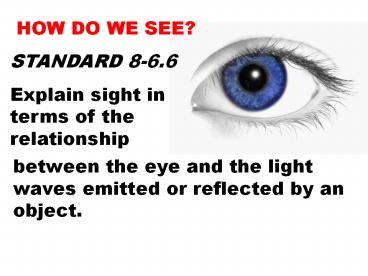HOW DO WE SEE? - PowerPoint PPT Presentation
1 / 18
Title:
HOW DO WE SEE?
Description:
HOW DO WE SEE? STANDARD 8-6.6 Explain sight in terms of the relationship between the eye and the light waves emitted or reflected by an object. VOCABULARY WORDS ... – PowerPoint PPT presentation
Number of Views:324
Avg rating:3.0/5.0
Title: HOW DO WE SEE?
1
HOW DO WE SEE? STANDARD 8-6.6 Explain sight in
terms of the relationship
between the eye and the light waves emitted or
reflected by an object.
2
VOCABULARY WORDS
LUMIONOUS OBJECTS Objects that emit their own
light NON-LUMIONOUS OR ILLUMINATED OBJECT
Materials that only reflect light
In order for objects to be seen by the eye, they
must give off or reflect visible light. The light
provided is from the sun or other light source.
GLOW-IN-THE-DARK objects release light that was
previously absorbed, even after the light sources
is gone.
3
Light affects the way we are able to view
objects. TRANSPARENT Objects can be seen
clearly through air, glass and other materials.
TRANSLUCENT When objects cannot be seen clearly
through material. The material is able to
transmit light. Example Frosted glass,
lampshades, tinted light bulbs.
OPAQUE When materials dont transmit light waves
at all. Example brick, Wood, rock,
4
Weve talked about the EM spectrum. What part do
we see?
The visible light is the white light. What is
white light made up of?
Newtons experiments with light proved that white
light was really composed of colors. PRIMARY
LIGHT COLORS IS WHAT WHITE LIGHT CAN BE FORMED
FROM. THE PRIMARY COLORS ARE RED, BLUE AND GREEN.
5
Magenta
RED
BLUE
White
Yellow
Cyan
SECONDARY LIGHT COLORS Where the primary colors
overlap
GREEN
Colored light and colored pigments are different
PIGMENTS Are colored materials that absorb
certain colors and reflect others
6
Light waves that have been emitted or reflected
by an object, enter the eye and first pass
through the transparent layer called the CORNEA
where they are refracted.
The light rays are then refracted again as they
pass through the transparent lens (convex)
7
As bright light enters our eyes, through the
PUPIL, the pupil gets smaller or CONTRACTS. In
dim light, the pupil enlarges or DILATES. This is
natures way of protecting the eyes from UV
radiation. This is why it is important to wear
sunglasses that are UV protected. If not, your
eyes will then dilate behind cheap sunglasses,
therefore allowing more harmful UV rays into the
eyes.
8
PROTECT YOUR EYES OR ELSE.
9
(No Transcript)
10
Behind the pupil is the LENS which focuses
incoming light rays onto the RETINA
11
The RETINA lies in the back of the eye. The lens
thickens as objects get closer to the eye and
projects an upside-down image onto the retina.
The retina consists of light-sensitive cells
called CONES AND RODS,
12
RODS help us distinguish between light and dark
and help us see at night.
CONES help us see color. Three types of
cones Each cone absorbs a different wavelength of
light. The three types of light are red, blue or
green.
13
When you see the green leaf your cones are
absorbing all of the colors of light except
green. The green light is reflected, or bent
back. Finally, the vision message is passed along
the OPTIC NERVE to the back of the brain, where
the image is processed.
14
COLOR FILTERS allow only certain colors of light
to pass/transmit through them. They absorb or
reflect all other colors. Example
15
(No Transcript)
16
(No Transcript)
17
Is everything you see the whole thing?? Never
judge a book by its cover.
18
(No Transcript)
























![❤[READ]❤️ 1,000 Places to See Before You Die (Deluxe Edition): The World as You've Never PowerPoint PPT Presentation](https://s3.amazonaws.com/images.powershow.com/10086513.th0.jpg?_=20240726065)




